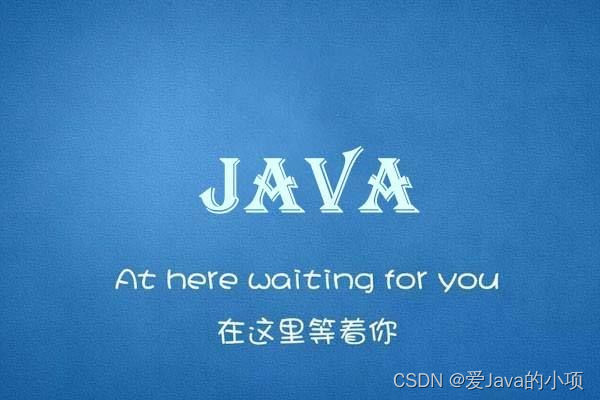👏👏👏 学习的痛苦是一时的,而没有学习的痛苦是一辈子的

目录
一、String类
1.String创建方式。
String name = "hello"; // "hello" 常量存储在字符串池中。
name = "zhangsan"; //"zhangsan" 赋值给name变量,给字符串赋值时,并没有修改数据,而是重新开辟空间。
String name2 = "zhangsan" ; //如果有就引用, 没有就重新开辟空间。
//字符串另一种创建方式 。
String s = new String("java是最好的编程语言")://在堆和栈里同时创建,栈里的指向堆里的。
String str = new String("java");
String str2 = new String("java");
System.out.println(str==str2);//返回false new 新建对象。 用equals 比较的数据返回true。2.String 常用的方法。
1. public int length(); //返回字符串的长度。 2. public char charAt(int index); // 根据下标获取字符。 3. public boolean contains(String str); // 判断当前字符串中是否包含str。 4. public char[] toCharArray(); //将字符串转换成数组 5. public int indexOf(String str); // 查找str首次出现的下标,存在,则返回该下标;不存在,则返回-1。 6. public int lastIndexOf(String str); // 查找字符串在当前字符串中最后一次出现的下标索引。 7. public String trim(); // 去掉字符串前后的空格 8. public String toUpperCase(); // 将小写转成大写。 9. public String toLowerCase(); // 将大写转成小写。 10. public boolean endsWith(String str); // 判断字符串是否以str结尾。 11. public boolean startsWith(String str); // 判断字符串是否以str开头。 12. public String replace(char oldChar,char newChar); // 将旧字符串替换成新的字符串。 13. public String[] split(String str); // 根据str做拆分。 public String[] split("[a,]"); //表示用a或,拆分。//正则表达式 public String[] split("[a,]+"); //+表示若连续的a或,也可以当作划分依据。 14. equalsIgnoreCase 不区分大小写的比较; s1.compareT o(s2); //比较的是按字典序,输出s1-s2(比较第一个不相等的字符)。
注意!: 若 String s1 = "abc"; String s2 = "abcxyz"; //若第一个或第二个和另一个除了多余部分都相等,则比较的是两个字符串的大小,返回第一个字符串的长度-第二个字符串的长度。
3.String案例
已知:String str = "this is a text";
需求:
1.将str中的单词单独获取出来
2.将str中的text替换为practice
3.在text前面插入一个easy
4.将每个单词的首字母改为大写
import java.util.Scanner;
public class Main {
public static void main(String[] args) {
String str ="this is a text";
//1将str中的单词单独提取出来
String[] arr = str.split(" ");
System.out.println("---------------1将str中的单词单独提取出来----------------");
for(String s : arr){
System.out.println(s);
}
//2将str中的text替换为practice
System.out.println("---------------2将str中的text替换为practice----------------");
String str2 = str.replace("text","practice");
System.out.println(str2);
//3在text前面插入一个easy
System.out.println("---------------3在text前面插入一个easy----------------");
String str3 = str.replace("text","easy text");
//4将每个单词的首字母改为大写
System.out.println("---------------4将每个单词的首字母改为大写----------------");
for(int i=0;i<arr.length;i++){
char first = arr[i].charAt(0);
//把第一个字符改成大写
char upperfirst = Character.toUpperCase(first);
String news = upperfirst+arr[i].substring(1); //从下标为1的位置截取到最后
System.out.println(news);
}
}
}4.StringBuffer与StringBuilder
StringBuffer: 可变长字符串,JDK1.0提供,运行效率慢、线程安全
StringBuilder: 可变长字符串,JDK5.0提供,运行效率快、线程不安全
注:StringBuffer和StringBuilder方法一模一样
StringBuffer sb = new StringBuffer();
1 sb.append(String str);//在字符串末尾追加
2.sb.insert(int index,String str);//在index位置添加str
3.sb.replace(int start,int end,String str);//下标为start到下标为end-1的位置替换为str,! 换头不换尾!
4.sb.delete(int start,int end);//删除下标为start到下标为end-1的位置5.StringBuffer与StringBuilder跟String类的对比
5.1.StringBuffer和StringBuilder 均比String效率高、节省内存
5.2.验证StringBuffer比String效率高
long start = System.out.currentTimeMillis();
String string="";
for(int i=0;i<99999;i++){
string+=i;
}
System.out.println(string);
long end = System.out.currentTimeMillis();
System.out.println("用时:"+(end - start));
//用时:47475
//System.out.currentTimeMillis() 表示从1970年1月1日到现在的毫秒数 long start = System.out.currentTimeMillis();
StringBuffer string="";
for(int i=0;i<99999;i++){
string+=i;
}
System.out.println(string);
long end = System.out.currentTimeMillis();
System.out.println("用时:"+(end - start));
//用时:308可以得出,明显用StringBuffer效率比String高。
二、BigDecimal类
1.前言
double d1=1.0;
double d2=0.9;
System.out.println(d1-d2);
//输出结果为0.099999999999999998这是因为double类型存储是双精度近似存储,但是在很多实际应用中需要精确运算,而double不符合要求。
2.位置 :java.math包中
3.作用:精确计算浮点数。
4.创建方式:
BigDecimal bd = new BigDecimal("1.0"); //一定要用字符串5.常用的方法:
BigDecimal bd1=new BigDecimal("0.9");
BigDecimal bd2=new BigDecimal("1.0");
//减法:substract 加法:add 乘法:multiply
BigDecimal r1 =bd1.substract(bd2);
System.out.println(r1);
//加法和乘法类似
//特殊:除法:divide 如果不能整除会报错 必须指明保留几位小数
//divide(BigDecimal bd,int scal,RoundingMode mode)
//参数scal:指定精确到小数点后几位
//参数mode:
//指定小数部分的取舍模式,通常采用四舍五入的模式
//取值为BigDecimal.ROUND_HALF_UP
BigDecimal r2 = bd1.divide(bd2, 2, RoundingMode.HALF_UP); //保留两位小数,且用四舍五入的方法
//例如 计算(1.4-0.9)/0.9
BigDecimal r2 =new BigDecimal("1.4").substract(new BigDecimal("0.5")).divide(new BigDecimal("0.9"));
三、Date类
1.创建:
Date date1 = new Date();2.常用的方法:
//今天的时间
Date date1 = new Date();
System.out.println(date1.toString());//打印日期
//输出结果:Mon Jun 20 18:31:56 CST 2022
System.out.println(date.toLocaleString());//打印日期,此方法虽已为过时的方法,但是比toString看起来更符合我们日常。
//输出结果:2022年6月20日 下午6:32:44
//昨天的时间
Date date2 = new Date(date1.getTime()-(60*60*24*1000)); //getTime() 返回从1970年1月1日到现在的毫秒数。
//after、before 方法
boolean b1 = date1.after(date2); //返回true 表示 date1 在 date2 后面
//compareTo方法
int d=date2.compareTo(date1);//返回-1表示date2比date小;1表示date2比date大;0表示date2和date一样大。
//equals方法
//比较是否相等 返回true or false。四、Calendar 类
1. 构造方法:protected Calendar() 由于修饰符是protected,所以无法直接创建该对象。但是Calendar提供了静态方法。
2.常用方法:
Calendar calendar = Calendar.getInstance(); //静态方法
System.out.println(calendar.getTime().toLocaleString());//输出现在的时间
System.out.println(calendar.getTimeInMillis()); //返回1970年1月1日到现在的毫秒数
//获取时间信息
int year = calendar.get(Calendar.YEAR); //月MONTH 天: DAY_OF_MONTH 小时: HOUR_OF_DAY(24)HOUR12(12) 分钟:MINUTE 秒:SECOND。
//其中MONTH 范围是0-11,所以用的时候MONTH+1。
//修改时间
Calendar calendar2 = Calendar.getInstance()
calendar2.set(Calendar.DAY_OF_MONTH,5);//表示将天数改为5.
//add方法修改时间
calendar2.add(Calendar.HOUR,1); // 加一个小时。
//获取当前月份中的最大天数和最小天数。
int max = calendar2.getActualMaximum(Calendar.DAY_OF_MONTH);
int min = calendar2.getActualMinimum(Calendar.DAY_OF_MONTH);
五、SimpleDateFormat 类
1. 位置:import java.text.SimpleDateFormat;
2.构造及常用方法:
SimpleDateFormat sdf = new SimpleDateFormat("日期格式字符串");
日期格式字符串,如:"yyyy-MM-dd hh:mm:ss"
yyyy 代表4位的年份
MM 代表2位的月份
dd 代表2位的日期
hh/HH 12小时制/24小时制
mm 代表分钟
ss 代表秒钟
a 代表AM/PM
————————————————
SimpleDateFormat sdf =new SimpleDateFormat("yyyy/MM/dd HH-mm-ss");
//创建Date
Date date= new Date();
//格式化date
String str = sdf.format(date);//输出按构造的格式输出
//解析(将字符串转成日期)
Date date2 = sdf.parse("1990/05/01 06-36-25");//必须按照构造的格式来写入。
//输出date2
System.out.println(sdf.format(date2.getTime()));六、Math类
求绝对值 Math.abs(-10) --> 10
四舍五入取整 Math.round(2.6) --> 3
求两个数最大值 Math.max(2,10) --> 10
求两个数最小值 Math.min(2,10) --> 2
随机数 Math.random() --> 0 ~ 1之间任意小数
求平方根 Math.sqrt(16) – > 4
求幂 Math.pow(2,3) – > 8
七、Random类
1.构造:
Random random = new Random();2.获得随机数:
random.nextInt(100); //0 ~ 100间随机整数八、System 类
//arraycopy:数组的复制
//src:原数组
//srcPos:从哪个位置开始复制
//dest:目标数组
//destPos:目标数组的位置
//length :复制的长度
arraycopy(src,srcPos,dest,destPos,length);
int [] arr ={20,18,15,8,35,26,45,90};
int [] dest=new int [8];
System.arraycopy(arr,0,dest,0,arr.length);
//currentTimeMillis() 返回从1970年1月1日 到现在的毫秒数
//用于计时
long start = System.out.currentTimeMillis();
String string="";
for(int i=0;i<99999;i++){
string+=i;
}
System.out.println(string);
long end = System.out.currentTimeMillis();
System.out.println("用时:"+(end - start));
//gc() 告诉垃圾回收器回收垃圾
//System.exit(0) 退出jvm 后面代码不会执行




















 536
536











 被折叠的 条评论
为什么被折叠?
被折叠的 条评论
为什么被折叠?










